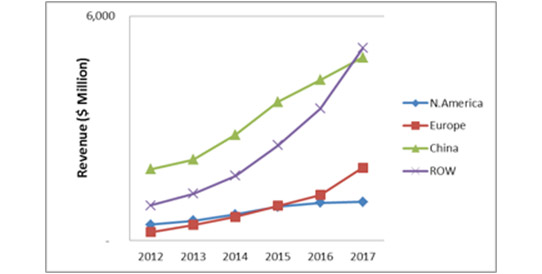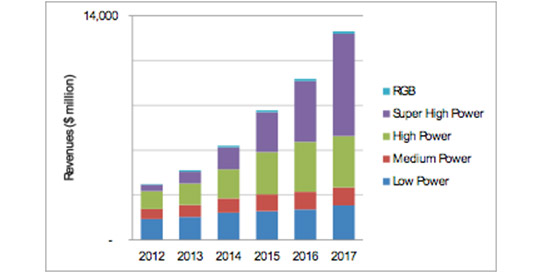- News
30 January 2014
Decline in packaged LED ASPs slowing as super-high-power LEDs rise to 50% of lighting shipments by 2017
Revenue for LEDs in lighting applications (including both replacement lamps and luminaires) are expected to rise at a compound annual growth rate (CAGR) of 30% to $13bn by 2017, according to a report ‘The Market for High-Brightness LEDs in Lighting Applications’ from Strategies Unlimited.

Picture: Market growth for LEDs in lighting by major region.
Over the last several years HB-LEDs have seen a precipitous fall in prices, which has helped to reduce the price of LED lamps and luminaires, but this decrease in prices has been slowing down in recent times, says the report. “Average selling prices (ASPs) of packaged LEDs are declining at a slower rate than previous years, as super-high-power LEDs increase in the market,” says Philip Smallwood, research director of LEDs and Lighting at Strategies Unlimited. “While prices for all LEDs are decreasing, the increased penetration of these SHP LEDs (which have a higher price) is raising the overall ASP for all packaged LEDs.” Super-high-power LEDs are predicted to be in 50% of LED lighting shipments in 2017.

Picture: The growing market share of super-high-power (>5W) LED packages in the coming years.
Efficacy improvements are continuing to take place in the market as well, with the average efficacy of commercially available LEDs for lighting applications rising to more than 100 lumens per Watt for 1W packages while multi-chip arrays reached an efficacy of 200 lumens per Watt. LED efficacy is no longer the gating factor for LED applications – cost is, says the report. Lighting applications have seen a variety of different packages used over the last year, including arrays, high-CRI (color rendering index), tighter color bins, directional, multi-directional and high-voltage LEDs.
Strategies Unlimited reports that the growth ra_te for LED package units and revenue are both expected to be in double digits for the forecast period. “While growth in the market can be attributed to improvements in the technology and decreases in its price, the largest penetration increases seem to be coming from government mandates that either restrict incumbent lighting technologies or push the usage of LEDs,” says Smallwood. “One of the largest impacts of these regulations will be seen in 2014 in the USA, as the implementation of the Energy and Independence Security Act of 2007 is phasing out 60 and 40W incandescent A-lamps,” he adds.
www.strategies-u.com/articles/reports/


